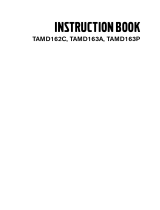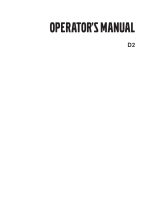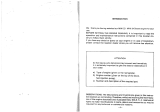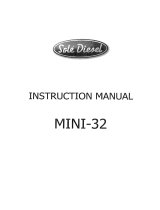5
Our joint responsibility
Volvo Penta continually commits a considerable part of
its development resources towards minimizing the
environmental impact of its products. Examples of areas
where we are always looking for improvements are;
exhaust emissions, sound levels and fuel consumption.
Regardless of whether your Volvo Penta engine is
installed in a boat used for pleasure or in commercial
operation, incorrect operation or improper maintenance
of the engine will result in disturbance or damage to the
environment.
In this Owner’s Manual there are a number of service
procedures, which, if not followed will lead to a deteriora-
tion of engine characteristics with regard to how it effects
the environment, its service life and cost of operation.
Always follow the recommended service intervals and
make a habit of checking that the engine is operating
normally every time you use it. One example is exces-
sively smoky exhaust. Contact an authorized Volvo
Penta workshop if you cannot correct the fault yourself.
Bear in mind that most of the chemicals used around
boats are harmful to the environment if used incorrectly.
Volvo Penta recommends the use of bio-degradable
degreasing agents for all cleaning. Always dispose of
engine and transmission oil waste, old paint, degreasing
agents and cleaning residue etc. at proper disposal
areas so they do not harm the environment.
Adapt speed and distance during your boat trips so that
swell and noise generated by the boat do not disturb or
harm wildlife, moored boats, landing stages etc. Wherev-
er you land or cruise, please show consideration and
always leave the areas you visit as you would like to find
them yourself.
Warranty and guarantee
A Service and Warranty Book with conditions for Volvo
Penta’s International Limited Warranty is supplied with
every engine. Contact your nearest Volvo Penta dealer
or importer for your copy if you have not received one.
Some markets can have other warranty conditions
depending on national legislation and regulations. These
conditions are provided by the Volvo Penta importer or
distributor for the market in question. If you wish to have
a copy of the conditions please contact your local Volvo
Penta representative.
Warranty Registration Card
The Warranty Registration Form (North American
market) or Warranty Card (other markets) should always
be filled out and sent in by the vendor. Make sure that
this has been done, since refusal of warranty can occur if
no proof of the delivery date can be provided.
Maintenance and care
– PDC (Pre Delivery Commissioning) delivery undertak-
ing, for marine engines: PDC enables us to ensure that
Volvo Penta products operate correctly after installation
in a boat, and further that the end-user gets acquainted
with the product, its functions and care (refer to the
Warranty and Service book). Delivery undertaking “PDC“
is carried out at the time of the delivery of the boat to the
end-user. The cost of this work is covered by the Volvo
Penta International Limited Warranty.
– First Service inspection, for marine engines: A first
Service Inspection must be carried out after operating
the engine for 20–50 hours or within 180 days from the
delivery date, or the end of the first season, whichever
occurs first. Labor and material costs in connection with
the First Service Inspection are not covered by the Volvo
Penta International Limited Guarantee (for checklist see
your Warranty and Service book).
Regular maintenance should be carried out after the First
Service Inspection in accordance with the maintenance
scheme in this book. Any work carried out in addition to
maintenance services should be documented (refer to
the Warranty and Service book)
It is an absolute condition for the Volvo Penta Interna-
tional Limited Warranty to apply that the PDC Delivery
undertaking and First Service Inspection have been
carried out by an authorized Volvo Penta Service dealer.
Volvo Penta Service
Volvo Penta has a comprehensive dealer network that
offers both service and spare parts for Volvo Penta
engines. Volvo Penta dealers are carefully selected and
then trained in order to provide customers with profes-
sional assistance on engine service and repairs. These
dealers have the special tools required to carry out the
work and the test equipment that ensures a high service
standard. They are required to keep a stock of Volvo
Penta Original Spare Parts and accessories that cover
most requirements. When ordering service or spare parts
always quote the complete engine and/or drive/reverse
gear model designation and serial number. These are
stated on the engine product plate and on a label on the
engine valve cover.





























